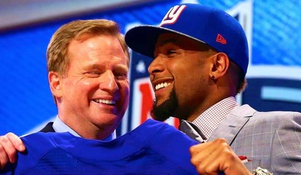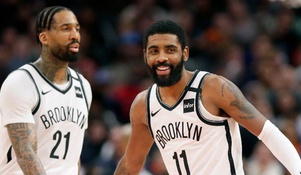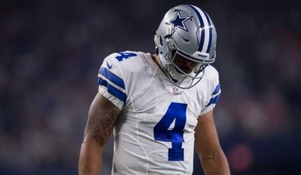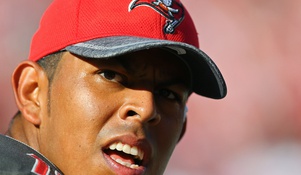Revisiting the Buccaneers terrible 2016 Draft (they drafted a kicker in the second round)

The 2016 NFL Draft will be remembered as one of the best in NFL history. The first seven selections in this draft have all made it to the pro-bowl in their careers and look like potential Hall of Fame candidates. This draft proved to be a deep one as well with talented players in the second round like Michael Thomas and Derrick Henry and even late finds like Tyreek Hill and Matthew Judon that have all impacted the game as we know it today. The Tampa Bay Buccaneers didn't just squander the opportunity they were given in this draft, they drafted so poorly it makes you wonder how Jason Licht is still the General Manager of the franchise (if I had to guess, it's because he was able to lure Tom Brady over to Tampa since he used to work in New England).
For some background, the Bucs were coming off a disappointing 6-10 season but with a lot to be excited about. The 2015 season was a 4-win improvement from going 2-14 in 2014 and the Buccaneers showed promise under rookie Jamies Winston and a few rising stars. The 2016 draft was going to be the one that would put the Bucs over the hump and potentially back into the playoffs for the first time since 2008.
While the Buccaneers possessed a solid offense in 2015, with play-makers that included Mike Evans, Vincent Jackson, Doug Martin and Cameron Brate, the defense needed to be improved. The secondary was seen as a clear weakness and it made sense for the Bucs to draft a cornerback in the first round.
The Buccaneers made the right move trading from the ninth selection to the eleventh, capitalizing on the Chicago Bears urgency to draft edge rusher Leonard Floyd. This move gave them another second round pick, which would presumably help with the draft class.
The Buccaneers went on to draft Vernon Hargraves from Florida. Vernon Hargraves looked to be one of the best cover corners in the draft, many (myself included) thought Hargraves was going to make an immediate impact for the Bucs and greatly boost the defense. Hargraves was a solid nickel corner in his first season, but was never able to improve past that. Hargraves was a complete whiff for the Bucs and set the tone for the rest of the draft class for Tampa Bay. Hargraves was traded in the middle of this past season to the Texans and hasn't lived up to the hype that he was given coming out of college.
It's understandable why the scouts praised Hargraves even though his career never worked out. He was part of an incredible secondary at Florida that included six defensive backs that would go on to play in the NFL. While some programs in college can give the NFL multiple pros at one position, they can also help overshadow talent. Vernon Hargraves was good but part of a great secondary that made up for his errors. When he got to the NFL, and the other great players weren't there to bail him out, he was exposed.
We can also give the Buccaneers a pass since they needed a corner and the drop-off was major after Jalen Ramsey (the consensus best corner in the draft) but nobody was predicting such a drop-off.
We can also see from here an argument to just draft the best player available, regardless of position. The first round gives teams the classic dilemma; do they take the best player available or fill a team need? The Buccaneers could have drafted the best player despite not filling a need in the first round and then address their needs in the later rounds, especially since needs are very contemporary in the NFL. Vernon Hargraves is only a reminder of who the Buccaneers could have drafted instead (the players that were selected after Hargraves were Sheldon Rankins, Laremy Tunsil and Karl Joseph).
The Buccaneers had two selections in the second round. Trying to help the defense, they drafted edge rusher from Eastern Kentucky Noah Spence. Noah Spence like Vernon Hargraves looked promising but also like Hargraves his career never lived up to the promise. After three seasons where he only amounted 7.5 sacks (as a pass-rusher) he was waived by Tampa, his career looks to be a journey one as of now (maybe he'll breakout somewhere but it's very unlikely).
The next selection the Buccaneers made is what makes you question what the Buccaneers were thinking during the draft. The Buccaneers drafted a kicker in the second round. The Buccaneers had kicking problems in the previous season and thought they could erase those woes by taking a kicker early.
It made sense that they took one of the most accurate kickers in the history of college football, Robert Aguayo. Aguayo never missed an extra point at Florida State and hit 69 of his 78 field goal attempts. Despite these stats you can't go without thinking Why did the Buccaneers draft a kicker in the second round? They didn't just reach for Aguayo, they went all out and bet everything on him and traded a third round and a fourth round pick in the process (those picks ended up becoming KeiVarae Russell and Eric Murray but we'll ignore that). It should be noted that most kickers go undrafted or in the final round of the draft, a clear reminder that what the Bucs were doing was risky (and stupid).
Kickers are also considered one of the most replaceable positions in the NFL. There are about 40 or 50 humans in the world that know how to kick a football in between goalposts constantly from long distances. If a kicker has a bad day, they can be cut the next morning and another kicker will be signed until he has a bad enough day to get cut the next morning. With this short leash on kickers and the availability of kickers you once again can't go without asking Why did the Buccaneers draft a kicker in the second round?
Roberto Aguayo wasn't just bad, he was terrible. Going 22-31, he had the worst field goal percentage among qualifying kickers in his rookie season and was cut in the following pre-season. We don't know what happened to one of the most accurate kickers in college history but this makes you question why Tampa reached on a player that not only plays a position that is so psychological but also so replaceable.
The Buccaneers next draft pick was in the fourth round and they tried to re-tool their secondary by drafting another corner, Ryan Smith from North Carolina Central. Ryan Smith has spent most of his career as the third or fourth cornerback on the depth chart and with only one interception in his career thus far, it doesn't look like he'll be playing for the Bucs much longer.
The Buccaneer then drafted an offensive lineman to add depth to the line, Caleb Benenoch from UCLA. Despite starting the entire 2018 season, Benenoch had a rather uneventful run in Tampa and was cut at the start of the 2019 season. At this point in the draft many teams are just throwing darts at a dartboard so this selection isn't an outlier (although it should be noted that Jordan Howard was taken two spots later).
The Bucs drafted two players that made little impact (as expected this late in the draft) in the sixth round in Dan Vitale and Devante Bond, capping off the class for Tampa. The conclusion is that the Bucs did poorly, mainly with one selection. The Buccaneers happened to have drafted terribly throughout this draft and given the amount of talent in this class, the fact that the Bucs failed to land a single pro-bowler is also a disappointment. The underlying disappointment of this class was the 59th pick, this is a pick that many will look back on and wonder what the Bucs were thinking. Taking a kicker in the second round is what made a bad draft class into one of the worst in recent years.




